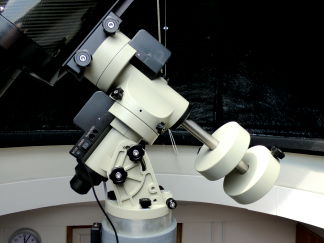

As soon as we want to image faint nebulae and galaxies (known collectively as Deep Space Objects or DSOs) we find ourselves needing to use exposures of minutes rather than seconds. Few mounts can keep the telescope pointing constantly in the same direction with adequate accuracy for such periods so that images become blurred due to movement of the subject during an exposure. The solution to this problem is to mount a second telescope with its own camera and to use the image of a star from this camera to control the mount to keep it pointing accurately in the required direction. This second telescope must be very rigidly attached to the primary telescope because any flexing between the two will cause tracking errors.
We have a choice of how to mount this second telescope. It may be mounted on top of the imaging telescope, or it can be mounted beside it. I have described a DIY method of mounting the second telescope on top of the primary elsewhere. I have now abandoned that method in favour of a simpler commercial solution. I have two telescopes that I normally use for imaging, an LX200 and a Ritchey-Chrétien (RC). The latter came with an additional dovetail bar on top of it, so I added a similar dovetail bar on top of the LX200; adaptors for doing this are available commercially. Also available commercially are dovetail bars with two (or three) dovetail clamps mounted on them. The only problem with the one I bought is that the separation between the two clamps cannot be adjusted and the construction is such that it cannot be modified easily by the amateur. (There are reasons to keep the two telescopes as close together as possible.)
Mounting the guide system on top of the imaging telescope is the simplest solution, and is the only solution if using a telescope on a dedicated mount (such as the LX200 on its fork mount), but one has to be concerned as to whether or not the mount can bear the extra weight. However it causes a problem when using a German Equatorial Mount (GEM) in a dome. When the telescope points south (the most useful direction for imaging) the GEM puts the telescope on its side, so a top-mounted telescope is now on the side and this makes the position of the dome critical if both telescopes are to be able to see through the slot. My slot is wide enough but I would have to take care keeping it so as the telescope tracks the moving sky. Putting the second telescope beside the main optics means that, when pointing south, it is above or below the main telescope and can see through the slot with ease. (There is a problem if the object is low in the sky as one telescope is quite low in the dome and may not see over the lower lip.) The other disadvantage is that the side-by-side saddle is quite heavy at 3.35 kg.
 |
 | ||
| Figure 1 | Figure 2 | ||
The side-by-side arrangement causes another problem. It is necessary to have the mount in balance and, with this arrangement, it has to be balanced in three directions. Balancing about the RA axis is easily done by moving the counterbalance weights along the balance bar (figure 1), and my mount provides an electronic way of assessing the balance which makes it particularly easy. However balancing of the dec axis is normally done by sliding the telescope up or down in the clamp of the mount. This is tricky enough with a single telescope but with the double saddle, there are two telescopes to adjust, and their positions are linked from the point of view of balance; move one back and the other forward keeps the balance point the same. However it is also necessary to move the whole saddle through the dovetail clamp on the mount and this is very tricky with a heavy load on it. In whatever way one positions the mount, when you loosen the clamps the whole assembly tries to fall off, and it is difficult to control it and move it by small amounts. In my case the RC is very back heavy and putting its dovetail bar fully in the clamp leaves its weight significantly below the saddle; moving the ST80, which I use for guiding, forward can only just balance it out. In practice I need to add weights either on top of the RC or to the saddle bar (figure 2 in which the arrow points to two extra dovetail clamps added as ballast weight). The problem is that I am already close to the maximum weight recommended by the manufacturer whose customer-service representatives insist that I should not exceed. Following a suggestion made by one of their technicians, I have come up with a solution which puts the extra weight on the balance-bar side of the mount. The manufacturer tells me I can add as much weight as I like to this side of the mount so long, of course, as I retain balance about the RA axis. (There is a good reason to have a very small imbalance about the RA axis but I am ignoring this for the purposes of this discussion.)